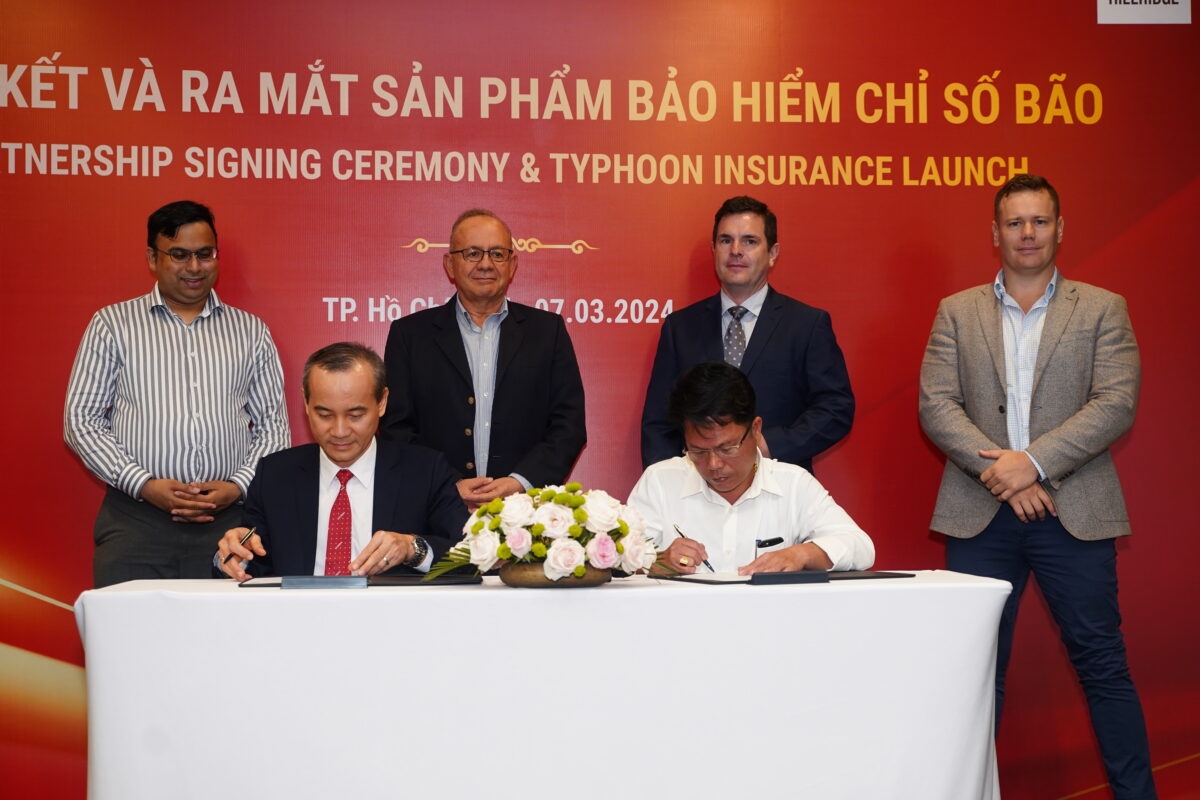Over 95 percent of Vietnamese farmers uninsured against adverse weather

Bao Minh Insurance team up with technology partner Hillridge to protect Vietnamese farmers
Hillridge and Bao Minh Insurance have today launched a new partnership that sees the dynamic Australian insurtech firm partner with local insurance leader Bao Minh Insurance to offer its new Typhoon Index Insurance product, a Vietnam-first new parametric product to protect Vietnamese Acacia timber farmers from the nation’s devastating typhoons.
Powered by Hillridge’s platform, Typhoon Index Insurance is based on a simple, online purchasing process, with a transparent and pre-determined calculation that will typically see farmers, plantations, and agribusinesses receive re-imbursement from Bao Minh for damage to their crops, plantations or livestock within ten days. Payouts are calculated by a satellite-based system that measures the severity of the typhoon and the distance of the farm from that storm.
“Unlike traditional indemnity-based insurance, where pay-outs are determined through a damage assessment that can see cumbersome processing times and delayed claims, parametric insurance pays out – typically within 10 days – based on a transparent, predetermined calculation,” explained Hillridge CEO Mr. Dale Schilling.
“This means that Vietnam’s farmers are quickly able to replenish their stocks and replant their crops, rather than waiting for a prolonged assessment and claims period that delays their ability to revitalize their livelihoods once the storm has passed,” Mr. Nguyen Ngoc Anh, Bao Minh Insurance’s Executive Vice President continued.
Vietnam – which has an annual typhoon season that stretches from June to November, typically sees 4-6 major tropical storms hit its shores each year – has a particularly vulnerable agriculture sector, which is frequently devastated when these storms strike land. For example, 2017’s Typhoon Damrey saw 22 trillion VND (roughly US$ 1 billion)[1] of economic damage to farmers, notably in forestry, agriculture and aquaculture.
“Vietnam is particularly susceptible to weather volatility, and that further increases the risks that Vietnamese farmers find themselves living with,” said Schilling. “Of particular concern is climate change, which sees the typhoons striking Vietnam carrying more rain than in the past, triggering catastrophic events including floods and landslides.”
Alarmingly, less than 5 percent of farmers nationwide are insured against these kind of adverse weather events.
The system relies upon satellite-based weather monitoring from the University Corporation for Atmospheric Research (UCAR), which is sponsored by US government agency the National Science Foundation, coupled with classifications defined by the Vietnam Meteorological Hydrological Administration.
Based upon this data, Hillridge’s award winning system processes claims based on typhoon windspeeds and distance (within 100 km) from the insured farmer.
At a ceremony held in Ho Chi Minh City earlier this week, under the witness of USAID’s Sustainable Forest Management Project’s representatives, Hiep Thuan Agricultural Cooperative became the new product’s inaugural customer. The cooperative’s representative Mr. Nguyen Huu Duong inked a deal with Bao Minh’s Mr. Nguyen Ngoc Anh to insure farmers in Quang Nam Province’s Hiep Thuan Agricultural Cooperative against adverse weather incidents and the impacts of longer-term climate change. USAID is supporting the first year of the insurance’s implementation, along with other technical assistance to Hiep Thuan.
“We believe that with this insurance policy, especially with technical assistance from USAID, we can help 40 forest owners cover 154.46 hectares of Acacia plantation forest under improved forest protection practices, create peace of mind for forest owners to develop the local materials areas and therefore increase the market access for the certified timber of our cooperative,” Mr. Nguyen Huu Duong remarks.
Mr. Duong adds further: “We commit to become a bridge with insured cooperative members to implement the program effectively under the contract. At the same time, we will strengthen the communication to forest owners in the area to attract community participation to continue expanding insurance coverage to the remaining 1,200 hectares of cooperative and mobilize more participation of preliminary processors, processors and traders in the local Acacia chain.”
This project aims to pilot this insurance program and provide a platform that can be adapted and adopted for other stakeholders, including forest owners, businesses, and government agencies. With this foundation in place, Bao Minh is bullish about the potential of this new product for Vietnam’s agriculturalists.
“We see tremendous opportunities for this product for farmers in sectors including aquaculture, forestry, and crops including fruits, sugarcane and rubber, notably in Vietnam’s central provinces such as Thanh Hoa, Nghe An, Quang Nam, Binh Dinh and Binh Thuan, which face devastating storms every year,” said Mr. Nguyen Ngoc Anh.
“These industries are not just vital for the incomes of the impacted farmers and their families, but also for the nutrition of Vietnam and its people, as well as representing significant export businesses for the economy of the entire nation.”
Policies are available with cover from as low as 10 million
VND, up to 75% of the entire insured value of the farmer’s assets – ensuring
affordable and accessible cover no matter the scale of the farmer’s operations.
Schilling explains: “We were the first company in
Australia to bring this kind of technology to farmers there, and now are
bringing a Vietnam-first technology to market. We recognize that Vietnam’s
farming community represents a diverse range of enterprises, ranging from
small, individual operations, to medium size enterprises, all the way up to
very large operators. We wanted to ensure that we were offering a product that
could be scaled to any of their needs and prevent any farmer from being
financially excluded from their stocks, crops or family’s livelihoods.”

 Xem Tiếng Việt
Xem Tiếng Việt 

